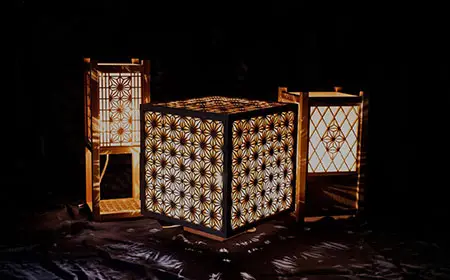
SEEING TOKYO’S DIVERSE LAYERS THROUGH ARCHITECTURE
Uncover centuries of cultural and architectural gems of Tokyo through a unique walking tour which takes visitors to historical hubs including Akasaka, as well as the work of some of Japan’s most celebrated architects Kengo Kuma and Kenzo Tange, and renowned artist Isamu Noguchi.
Tokyo is more than a world-leading metropolis. Its myriad network of streets and diversity of land use, spread over its vast expanse, offer clues of a rich and complex history.
Nagatacho-Akasaka is but one example of a compact and dense district consisting of all kinds of buildings, from governmental, diplomatic, and business to shopping, entertainment, and residential. There are many reasons for this complexity, which can be uncovered while enjoying a stroll led by two leading authorities in art and architecture who have devised a tour of the Nagatacho-Akasaka area that introduces various spots through architecture. Mr. Ryoma Murata is involved in research and education as well as architectural design while Ms. Haruka Soga is an interpreter and guide well versed in architecture.
The unique walking tour begins at The Capitol Hotel Tokyu, a site with a long history due to its proximity to Edo Castle (today’s Imperial Palace). During the Edo period (1603–1867), the prized location was home to samurai but the Meiji Restoration of 1868 resulted in their removal and their mansions’ reallocation for new government facilities. Still, even today, due to this history, the area is renowned as a center of power.
The Capitol Hotel Tokyu is located on the site of a former membership restaurant that operated on the site from 1881 to 1945. Since then, the site has been home to a hotel, with the current building constructed in 2010.

Its reception area showcases two impactful works by Toko Shinoda, an esteemed artist known for paintings featuring bold calligraphy brushstrokes. With one painted in 1963 and the other in 2010, the viewer can appreciate their contrasts and the evolution of her work over decades. 

The hotel also conveys intriguing aspects of Japanese culture. Designed by renowned architect Kengo Kuma, the lobby’s ceiling features a modern interpretation of designs inspired by traditional to-kyo (a structural element used in wooden temples to join pillars to the roof frame) and engawa (the covered corridor that runs around the exterior perimeter of buildings). A huge ikebana flower arrangement and expansive water feature that extends to the garden have the effect of merging the indoor and outdoor space, bringing nature closer. These designs are a nod to the role the engawa has played for centuries as a place for informal communication among neighbors. It helped facilitate the development of relationships, which it continues to do in its modern form for guests of the hotel.

A short walk from Sotobori-dori — passing over a road that was once the outer moat of Edo Castle — leads to Akasaka’s downtown area, which is packed tightly with shops, eateries, and small bars. Here, visitors are introduced to Four Deer Building (Glass Art Akasaka). Created by renowned architect Arata Isozaki, the structure features a black glass façade, which is transformed at night with a glow that brings creative designs to life, and a unique indoor/outdoor stairwell that extends to the sky.

The shopping street of Hitotsugi-dori is a remnant of a centuries-old relay point for messengers. The street features special utility poles. They are designed by Kazuhiro Ishii — the celebrated post-modernist architect behind many buildings on the art island of Naoshima — who was inspired by the sandogasa (wide straw hats) worn by these messengers.

A short distance further and visitors enter a residential area of houses and apartment buildings. At the end of one of the side streets, in a spot discernable only to knowledgeable guides, lies Suzufuri Inari Shrine. This tiny Shinto shrine dates from the 17th century. In that period, a shrine, a communal toilet and wells were set up in each block as a typical town structure, which acted like a hub for residents. Each block had its own shrine, and 80,000 shrines still exist in Japan: a remnant of this tradition.

The conclusion of the experience is Sogetsu Kaikan, the home of Sogetsu Ikebana and other creative activities. Designed by renowned architect Kenzo Tange, the dramatic glass building contrasts strikingly with the serenity of the flower, stone, and water plaza “Heaven” by renowned artist Isamu Noguchi.
 © 2024 The Isamu Noguchi Foundation and Garden Museum/ARS, NY/ JASPAR, Tokyo E5551
© 2024 The Isamu Noguchi Foundation and Garden Museum/ARS, NY/ JASPAR, Tokyo E5551
Known for his sculpture and public artworks, Noguchi was awarded recognition from early in his career and traveled widely in Europe and the Americas to create his artworks, which include The Garden of Peace at UNESCO’s headquarters in Paris.
In the 1970s, Noguchi and Tange were able to collaborate on the Sogetsu Kaikan project, fulfilling the friends’ long-term dream to work together. Following the avant-garde tradition of the ikebana school, the garden is traditional in style while also incorporating freestyle elements of art. Its concept is using natural items, including stones, water, and flowers, to convey the power of nature.

Looking out from the viewing area onto the stone garden, visitors are reminded of the ikebana arrangement at The Capitol Hotel Tokyu, which was created by Sogetsu Ikebana. The feeling is of coming full circle and realizing that Tokyo’s architectural facets exist in harmony, even in their fascinating diversity.
*The experience introduced in this article is arranged by a national licensed tour guide Ms. Haruka Soga with the special support from the Capitol Hotel Tokyu.
Please contact her via the website Behind the Scenery for more information.
Contact:
Behind the Scenery
https://www.behind-the-scenery.com/


















